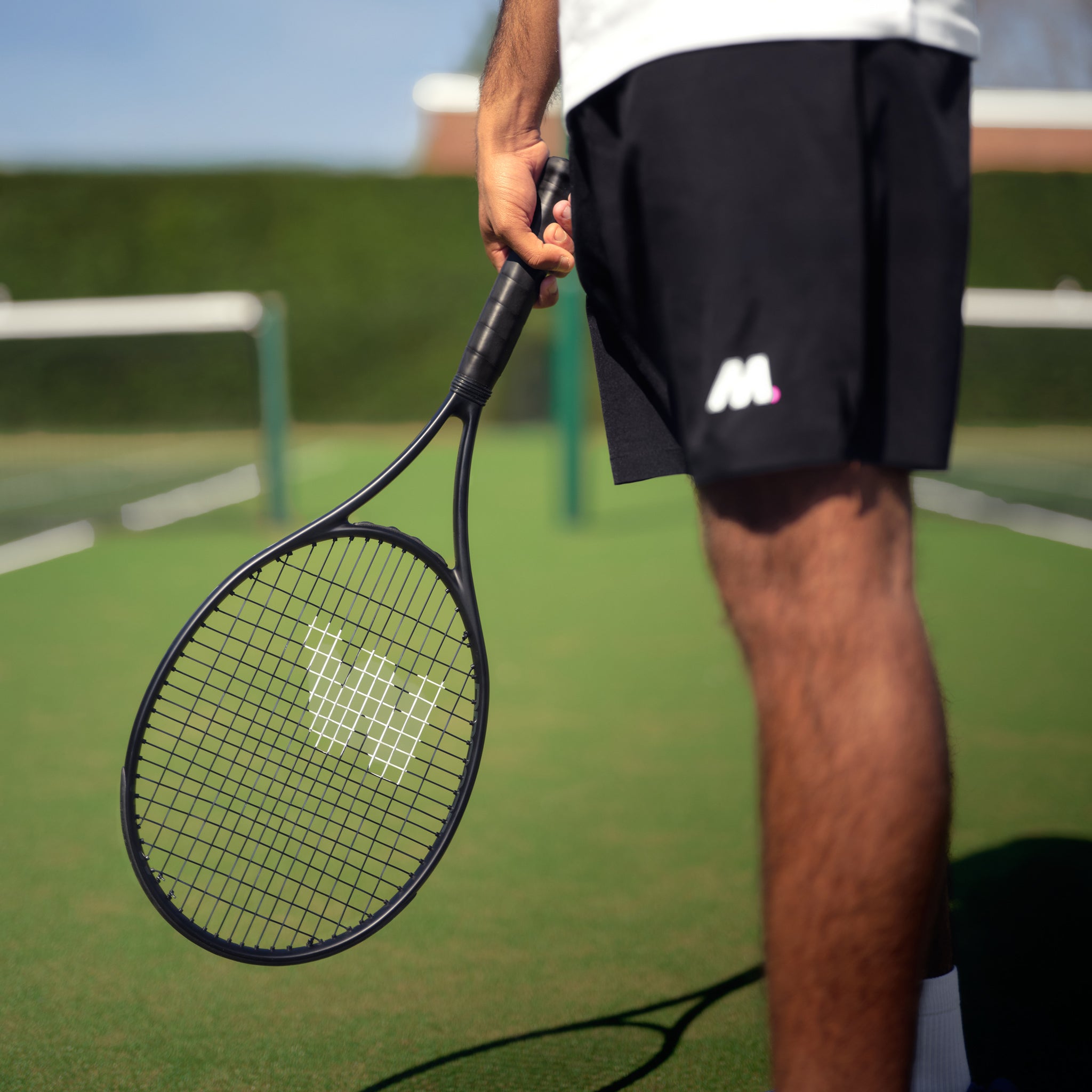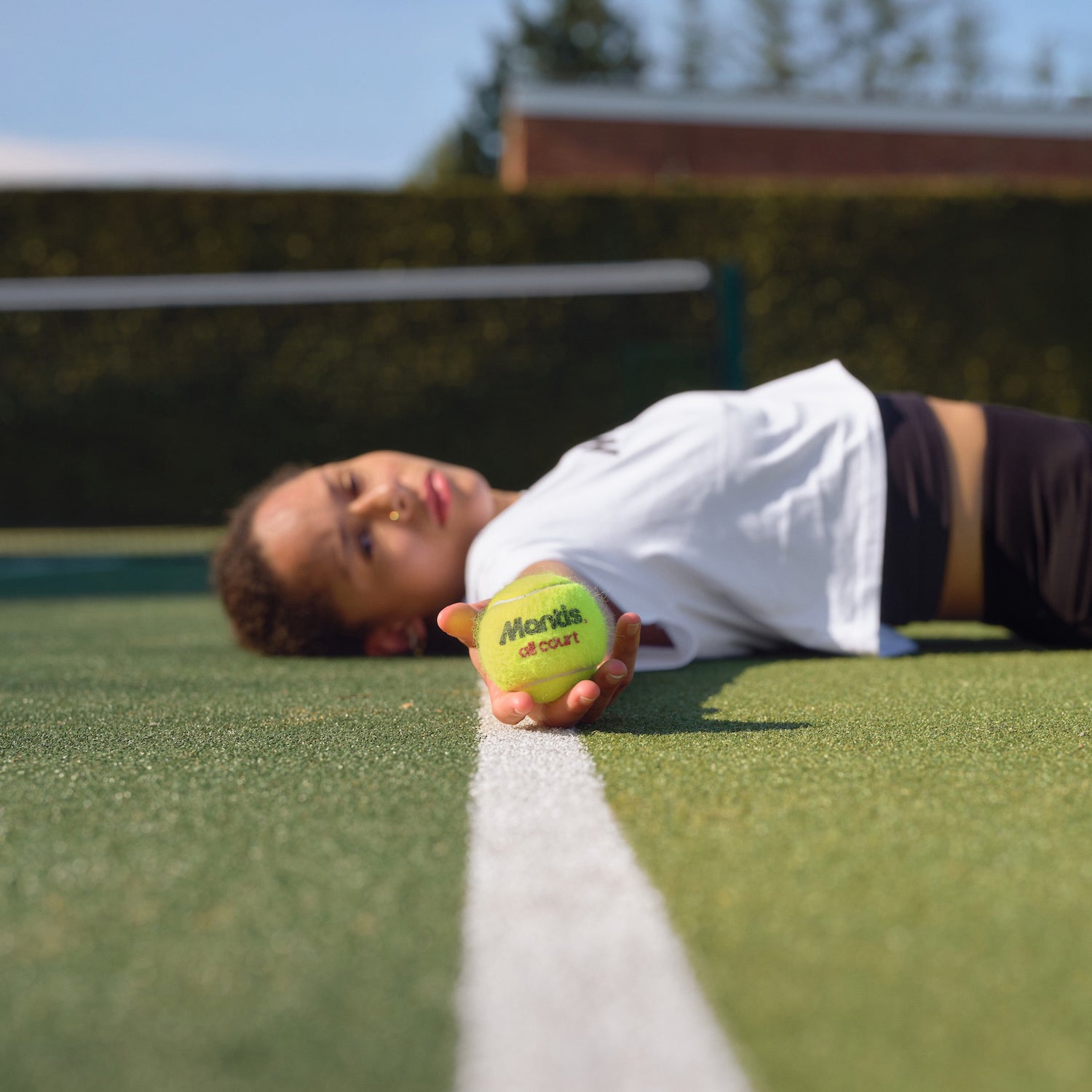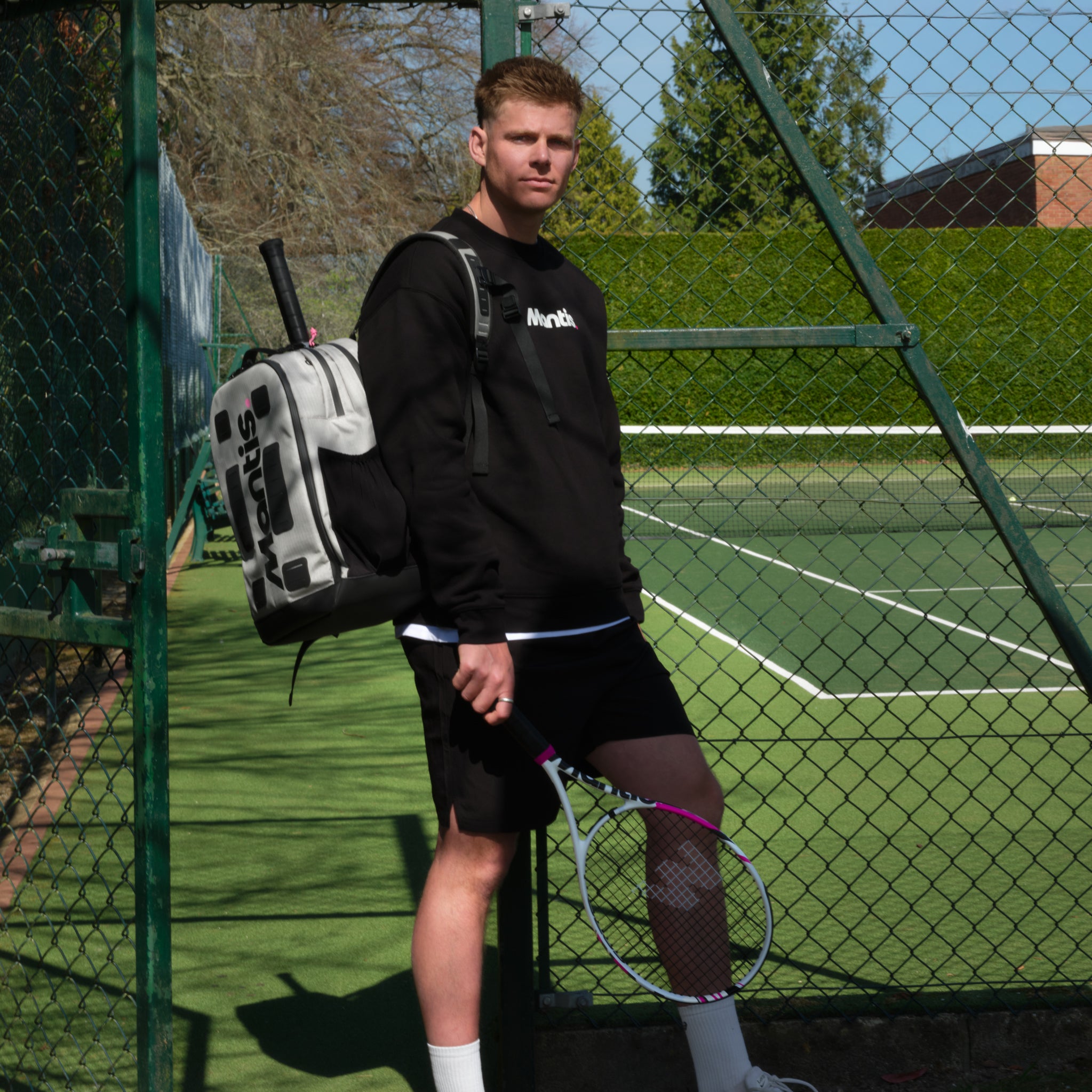
Stepping onto the court cold is a recipe for unforced errors and potential injury. At Mantis, we believe that a dedicated warm-up isn't just about getting loose; it's about priming your body for the explosive, multi-directional movements that define the modern game. Preparation is as crucial as the equipment you choose, like our Mantis tennis rackets, which is why we’ve developed this comprehensive guide to the best tennis warm up exercises. These movements are designed to prepare your body for the specific demands of a match, ensuring you can react quickly and powerfully from the very first point.
A key benefit of this preparation lies in its ability to refine your body's mechanics, essential for optimizing your movement patterns on the court. This structured routine will elevate your heart rate, activate key muscle groups, and sharpen your neuromuscular connections. In this guide, we will break down eight essential exercises, from dynamic leg swings to shadow swings, providing clear instructions and explaining the specific benefits each one brings to your game. By integrating these practices, you establish a solid foundation for performance and injury prevention, making every pre-match routine your first victory of the day.
1. Arm Circles and Shoulder Rolls: Preparing for Power
Arm circles and shoulder rolls are foundational dynamic stretches vital for any comprehensive tennis warm-up. This exercise involves rotating the arms and shoulders through their full range of motion, a crucial first step before you even think about picking up one of our high-performance Mantis tennis rackets. The primary goal is to increase blood flow and synovial fluid to the shoulder joint, which warms up the intricate rotator cuff muscles and prepares the entire shoulder girdle for the explosive demands of serving, smashes, and powerful groundstrokes.
At Mantis, we recognise the shoulder as the epicentre of power for serves and smashes, making this exercise non-negotiable. It's a staple in tennis academies worldwide and can be seen in the pre-match routines of countless ATP and WTA tour professionals. Its inclusion is championed by sports medicine professionals and elite trainers because it directly addresses the high-risk nature of the shoulder in tennis, helping to prevent common injuries like rotator cuff tears and impingement.
How to Perform and Why It Works
This simple yet effective movement is key to activating the deltoids, rotator cuff, and surrounding stabiliser muscles.
- Execution: Stand with your feet shoulder-width apart and arms extended to your sides. Begin by making small, controlled circles with your arms, gradually increasing the size. Perform 10-15 repetitions forward, then reverse the direction for another 10-15 repetitions. Follow this with 10 slow shoulder rolls forward and 10 backward, shrugging your shoulders up towards your ears and rolling them back and down.
- Key Benefit: This dynamic stretching improves joint mobility and elasticity in the muscles and tendons. Warming these tissues makes them less susceptible to strain or tearing during high-velocity movements on the court.
Expert Tip: Focus on smooth, deliberate movements rather than speed. The aim is to feel a gentle stretch and an increase in warmth around the shoulder, not to force the joint into uncomfortable positions. This controlled approach is a hallmark of professional tennis warm up exercises.
2. Dynamic Leg Swings: Unlocking Hip Mobility
Dynamic leg swings are a cornerstone of any effective pre-match preparation, designed to ready the lower body for the rigours of the court. This crucial exercise involves controlled leg movements through various planes of motion, specifically targeting the hips, hamstrings, and hip flexors. It is an essential step to perform before you even think about the intense on-court rallies, which demand maximum effort from your body and your equipment, like our durable Mantis tennis balls. The main purpose is to actively increase the range of motion in the hip joint, preparing it for the explosive lateral movements, lunges, and split steps inherent in tennis.
At Mantis, we understand that a player's movement and court coverage originate from the hips. This is why dynamic leg swings are a non-negotiable part of the warm-up. You'll see elite players like Novak Djokovic incorporating them into their pre-match routines, and they are a standard practice in collegiate tennis programmes and recommended by the International Tennis Federation. Sports physiotherapists and elite coaches champion this exercise because it directly prepares the lower body for sport-specific actions, significantly reducing the risk of muscle strains and groin injuries.
How to Perform and Why It Works
This dynamic stretch is key to activating the glutes, hamstrings, quads, and crucial hip flexor muscles, preparing them for rapid changes of direction.
- Execution: Stand sideways to a fence or wall for balance, holding on with one hand. Begin with forward-and-backward leg swings, keeping your leg relatively straight but not locked. Perform 10-15 controlled swings. Then, turn to face the fence and perform side-to-side (lateral) swings, moving your leg across the front of your body. Complete 10-15 swings per leg in each direction.
- Key Benefit: This movement improves hip mobility and warms up the major muscle groups of the legs. By mimicking the motion of running and lunging, it enhances neuromuscular activation, meaning your muscles will be ready to fire more efficiently and powerfully from the very first point.
Expert Tip: Keep your core engaged and your upper body stable throughout the movement. The motion should come from the hip, not from twisting your torso. Start with smaller, controlled swings and gradually increase the height and range as you feel the muscles warming up. This controlled progression is a vital component of professional tennis warm up exercises.
3. High Knees and Butt Kicks: Igniting Your Footwork
High Knees and Butt Kicks are dynamic, cardiovascular-focused drills that form the engine of a tennis player's warm-up. These exercises elevate the heart rate while specifically targeting the leg muscles and refining running mechanics crucial for explosive court coverage. Before you even grip your racket, preparing your body for the sharp, sudden movements of a match is vital, and these drills are a perfect way to activate the lower body, a key part of our player development philosophy at Mantis. The primary aim is to increase body temperature and prepare the hamstrings, quadriceps, and glutes for the intense demands of sprinting, lunging, and changing direction.
At Mantis, we understand that a match is often won with the feet. That's why these exercises are non-negotiable staples in the routines promoted by elite tennis academies like IMG Academy and are seen in nearly every professional's pre-match preparation. Championed by track and field coaches and tennis fitness specialists alike, their inclusion is based on proven principles of athletic preparation. They effectively prime the neuromuscular system for rapid-fire muscle contractions, helping to reduce the risk of muscle pulls and strains during play.
How to Perform and Why It Works
This combination rapidly warms the body's largest muscle groups and improves coordination, making it one of the most efficient tennis warm up exercises.
- Execution: Begin with High Knees by jogging in place or moving forward slowly, driving one knee at a time up towards your chest. After 30 seconds, transition to Butt Kicks, focusing on kicking your heels back towards your glutes, again for 30 seconds. Maintain an upright posture throughout, keeping your core engaged and landing lightly on the balls of your feet.
- Key Benefit: These movements dynamically stretch the quadriceps (High Knees) and hip flexors/hamstrings (Butt Kicks) while simultaneously elevating your heart rate. This dual-action approach ensures your muscles are both warm and pliable, ready for the stop-start nature of a tennis point.
Expert Tip: Focus on rhythm and control over speed or height. The goal is to establish a smooth, continuous motion that feels athletic and controlled, not forced. This mimics the coordinated footwork patterns you'll rely on during a competitive match.
4. Lateral Shuffles: Mastering Court Coverage
Lateral shuffles are a dynamic exercise that directly mimics the essential side-to-side movements required in tennis, making them a cornerstone of any effective warm-up routine. This drill involves moving sideways while maintaining a low, athletic stance, preparing the body for the rapid directional changes needed to cover the court. It specifically targets the adductors (inner thighs), glutes, and key stabilising muscles, crucial for explosive lateral agility. These movements are fundamental, which is why mastering them is a key focus in our comprehensive guide to essential tennis footwork drills.
At Mantis, we understand that matches are often won and lost based on footwork and court positioning. Lateral shuffles are a non-negotiable warm-up component for this reason. This exercise is heavily utilised by professional players like Rafael Nadal, whose legendary court coverage is built on a foundation of exceptional lateral speed. It is a standard drill in tennis-specific training programmes and competitive junior coaching, championed by movement specialists for its direct translation to on-court performance and injury prevention, particularly for groin and hip strains.
How to Perform and Why It Works
This exercise is critical for activating the lower body and establishing the movement patterns you will rely on during a match.
- Execution: Start in an athletic stance with your knees bent, back straight, and feet slightly wider than shoulder-width apart. Push off your trail leg and take a step sideways with your lead leg, followed quickly by your trail leg to return to the starting stance. Shuffle for 10-15 metres in one direction and then repeat in the opposite direction.
- Key Benefit: This drill elevates your heart rate while simultaneously warming up the exact muscle groups used for covering wide shots. It improves coordination, balance, and the neuromuscular pathways responsible for quick, efficient side-to-side movement.
Expert Tip: Focus on staying low and maintaining a consistent rhythm with light, quick steps. Avoid crossing your feet or bobbing up and down. Keeping your feet parallel throughout the movement is a key detail in professional tennis warm up exercises that maximises stability and power.
5. Trunk Rotations: Fuelling Your Core Power
Trunk rotations are a cornerstone of any effective pre-match routine, specifically designed to awaken the core muscles that drive every shot in tennis. This dynamic exercise involves twisting the torso to prepare the spine, obliques, and deep abdominal muscles for the intense rotational forces generated during groundstrokes and serves. Before you grip one of our premium Mantis tennis racket strings and unleash a powerful forehand, engaging your core is essential. This movement primes the kinetic chain, ensuring power is transferred efficiently from your lower body, through your core, and into the racket.
At Mantis, we understand that a strong, mobile core is the engine of a tennis player. Elite athletes like Serena Williams have long incorporated core-focused movements into their preparation, a practice championed by tennis biomechanics experts and professional coaches. Including trunk rotations in your warm-up is a proactive step, endorsed by sports medicine specialists to improve spinal mobility and reduce the risk of lower back and oblique strains, which are common in a rotation-heavy sport like tennis.
How to Perform and Why It Works
This exercise activates the crucial muscles responsible for generating and controlling rotational power, a fundamental component of every tennis stroke.
- Execution: Stand with your feet slightly wider than shoulder-width apart and your knees slightly bent. Hold your arms out in front of you or across your chest. Keeping your hips relatively stable and facing forward, slowly rotate your torso from one side to the other. Start with small, controlled movements and gradually increase your range of motion as you feel the muscles warm up. Perform 15-20 rotations to each side.
- Key Benefit: This movement specifically prepares the obliques and transverse abdominis for the explosive twisting required on court. A warmed-up core provides better stability, balance, and a more powerful, fluid swing, making it one of the most functional tennis warm up exercises you can perform.
Expert Tip: The rotation should originate from your core, not from swinging your arms. Focus on keeping your head and hips as still as possible to isolate the torso. This ensures you are activating the deep stabilising muscles rather than just creating momentum.
6. Wrist and Forearm Circles: Enhancing Grip and Control
Wrist and forearm circles are a vital, often overlooked, component of a thorough tennis warm-up. These targeted movements prepare the delicate joints and muscles of the wrist and forearm for the repetitive, high-impact nature of the sport. Before gripping one of our precisely balanced Mantis tennis rackets, mobilising these areas is essential for generating racquet head speed, executing nuanced shots like drop shots and volleys, and absorbing shock effectively upon impact. The primary aim is to lubricate the wrist joint and activate the forearm flexors and extensors.
At Mantis, we understand that control and feel originate in the hands and travel up the arm. Neglecting the wrists and forearms is a significant oversight that can lead to common ailments like tennis elbow and wrist strain. This is why the exercise is a standard in rehabilitation programmes and is regularly practised by professional players, especially those with a history of arm injuries. Tennis medicine specialists and physical therapists champion these movements for their preventative benefits, ensuring the forearm is ready for the constant tension and vibration of a match.
How to Perform and Why It Works
This simple exercise directly targets the muscles responsible for grip strength and stability, which are crucial for every single shot you hit.
- Execution: Extend your arms straight out in front of you with your palms facing down. Slowly rotate your wrists in a circular motion, making the circles as large as is comfortable. Perform 10-15 repetitions clockwise, then 10-15 anti-clockwise. Follow this by opening and closing your fists 10 times to warm up the fingers and forearm muscles further.
- Key Benefit: This dynamic stretch improves blood flow and flexibility in the wrist joint and surrounding tendons. This preparation makes them more resilient to the strain of powerful strokes and helps prevent injuries.
Expert Tip: Focus on smooth, controlled rotations rather than fast, jerky movements. You should feel a gentle warming sensation in your forearms. Incorporate this not just in your pre-match routine, but also between sets or during changeovers to keep the muscles loose and responsive. This consistent care is a key element of effective tennis warm up exercises.
7. Shadow Swings: Rehearsing for Perfection
Shadow swings are a quintessential tennis-specific warm-up, involving the execution of strokes without a ball. This crucial exercise bridges the gap between general physical readiness and on-court action, priming the neuromuscular system for the specific movements of tennis. Before you even un-zip one of our premium Mantis tennis bags, engaging in shadow swings allows you to focus purely on technique, rhythm, and timing, activating the exact muscle memory required for play.
At Mantis, we view shadow swings as the dress rehearsal for a flawless performance. This practice is universal, seen in the routines of Grand Slam champions and beginners in their very first lesson. Its value is championed by elite coaches and tennis academies because it directly rehearses the biomechanics of each shot. This focused movement helps to groove correct form and build confidence, making it one of the most effective tennis warm up exercises for reinforcing good habits before a single ball is struck.
How to Perform and Why It Works
This exercise is your chance to fine-tune your technique and prepare your body for the specific demands of each stroke.
- Execution: Find some space and begin performing your main strokes: forehands, backhands, volleys, and serves. Start at 50% speed, concentrating on a full, fluid swing path. Gradually increase the intensity and speed with each repetition, mimicking match-level effort. Perform 10-15 swings for each type of stroke you plan to use.
- Key Benefit: Shadow swings activate the precise motor pathways used during a match. This neuromuscular activation significantly reduces the "cold start" feeling, allowing your body and mind to synchronise, leading to better timing and cleaner ball-striking from the first point.
Expert Tip: Visualise the entire sequence of a point. Imagine the incoming ball, your footwork preparation, the ideal contact point, and a complete follow-through. This mental rehearsal, combined with the physical motion, sharpens your focus and court awareness.
8. Light Jogging and Movement Drills: Elevating Core Temperature
Light jogging combined with specific movement drills forms the cardiovascular foundation of any effective tennis warm-up. This phase is about more than just getting the blood pumping; it elevates the core body temperature and activates the neuromuscular pathways needed for explosive, multi-directional court coverage. At Mantis, we emphasise that this isn't just a generic jog but a tennis-specific preparation, priming the body for the exact movements it will perform during a match. Proper activation here complements a dedicated tennis strength and conditioning programme, ensuring your muscles are not only strong but also ready to fire efficiently from the first point.
This exercise is a non-negotiable component in professional tennis warm-up protocols, from elite academies to the pre-match routines on the ATP and WTA tours. Tennis fitness coaches and sports science researchers champion this approach because it systematically prepares the entire body, reducing the risk of muscle pulls and strains that often occur when players go from stationary to high-intensity too quickly. It's the essential bridge between being static and being match-ready.
How to Perform and Why It Works
This sequence activates the major muscle groups in the legs and core while sharpening coordination and footwork patterns crucial for the game.
- Execution: Begin with 3-5 minutes of light jogging around the court, maintaining a conversational pace. Then, transition into movement drills along the baseline or sidelines. Perform each for the width of the court and repeat 2-3 times: forward running, backward running (backpedalling), side shuffles, and crossover steps (carioca).
- Key Benefit: This combination raises your heart rate gradually and warms the muscles, ligaments, and tendons throughout the lower body. The inclusion of tennis-specific movements like shuffles and crossovers directly rehearses the footwork patterns used in rallies, improving agility and balance from the outset.
Expert Tip: Focus on maintaining light, quick steps, staying on the balls of your feet. As you progress through the drills, gradually increase the intensity to better mimic match-play speed. This is a core principle of effective tennis warm up exercises, ensuring your body is fully prepared for the dynamic demands ahead.
Tennis Warm-Up Exercises Comparison Guide
| Exercise | Implementation Complexity | Resource Requirements | Expected Outcomes | Ideal Use Cases | Key Advantages |
|---|---|---|---|---|---|
| Arm Circles and Shoulder Rolls | Low | None | Improved shoulder mobility and joint prep | Pre-match warm-up, shoulder activation | Simple, no equipment, prevents shoulder impingement |
| Dynamic Leg Swings | Moderate | Minimal (balance aid optional) | Enhanced hip mobility, dynamic flexibility | Warm-up for explosive leg movements | Improves coordination, reduces injury risk |
| High Knees and Butt Kicks | Moderate | None | Cardiovascular activation, improved running form | Cardiovascular and leg muscle warm-up | Raises heart rate quickly, enhances coordination |
| Lateral Shuffles | Moderate | Adequate space | Improved lateral agility and court coverage | Tennis-specific agility training | Develops lateral speed, strengthens stabilizers |
| Trunk Rotations | Low to Moderate | None | Increased spinal mobility, better rotational power | Core activation before strokes | Enhances core stability, reduces back injury risk |
| Wrist and Forearm Circles | Low | None | Improved wrist mobility, injury prevention | Arm injury prevention and rehab | Prevents tennis elbow, simple to perform |
| Shadow Swings | Moderate | None | Neuromuscular prep, stroke mechanics refinement | Technique and match warm-up | Builds muscle memory, gradual intensity increase |
| Light Jogging and Movement Drills | Moderate to High | Adequate space | Full-body cardiovascular warm-up | Overall pre-match warm-up | Comprehensive warm-up, progressive intensity |
Integrating Your Warm-Up for Peak Performance
We've explored eight essential tennis warm up exercises designed to prepare your body for the unique demands of the court. Moving beyond a simple checklist, this routine is your strategic advantage, a critical ritual that sets the foundation for every serve, volley, and groundstroke. Consistently implementing these dynamic movements, from arm circles to shadow swings, is a direct investment in both your immediate performance and your long-term athletic health.
The true value of this warm-up lies in its holistic approach. Light jogging and lateral shuffles elevate your heart rate and prime your cardiovascular system, ensuring you have the stamina for long rallies. Dynamic leg swings and trunk rotations activate the major muscle groups responsible for generating power and executing explosive, multi-directional movements. Meanwhile, targeted exercises like wrist circles and shadow swings fine-tune the specific motor patterns you’ll rely on for racket control and shot precision. This isn't just about avoiding injury; it's about systematically switching on every component required for peak tennis performance.
Making Your Tennis Warm Up Exercises Your Own
The key to a successful warm-up is consistency and personalisation. While the exercises we've outlined provide a comprehensive framework, the most effective routine is one that is adapted to your individual needs.
- Listen to Your Body: On days you feel particularly stiff, spend extra time on dynamic stretches like leg swings. If a previous match left your shoulders feeling tight, dedicate more attention to arm circles and shoulder rolls.
- Adjust Intensity: Your warm-up should gradually increase in intensity, never starting at full throttle. The goal is to prepare your muscles, not exhaust them before the match even begins.
- Vary Your Drills: While the core eight exercises are fundamental, you can incorporate variations to keep your routine engaging. This prevents mental fatigue and ensures you remain focused during this crucial pre-match period.
By internalising this sequence, you transform a series of movements into a powerful pre-performance ritual. To truly maximise your readiness and performance, consider exploring additional specialist stretches that improve workout performance to supplement your routine and address specific mobility concerns.
Key Takeaway: A structured, consistent warm-up is not an optional extra; it is as fundamental to your success as your racket or your technique. It bridges the gap between being physically present on the court and being fully prepared to compete at your highest level.
Ultimately, mastering these tennis warm up exercises is about taking control of your preparation. It demonstrates a commitment to excellence that extends beyond the match itself. At Mantis, we believe that purposeful preparation is the cornerstone of victory. Treat your warm-up with the same dedication you bring to every point, and you will unlock a new level of consistency, power, and confidence in your game. You are no longer just ready to play; you are organised and prepared to win.
Just as a dedicated warm-up prepares your body for the game, the right equipment ensures your technique translates into results. At Mantis, we engineer high-performance tennis rackets and gear designed for precision and power. Explore our collection and equip yourself for victory.








